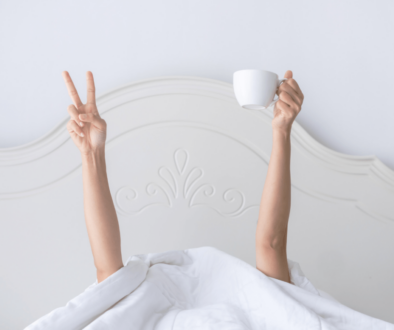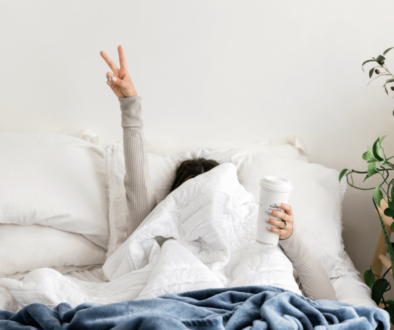Your Sleep Revolution: Easy Bedroom Hacks for Better Rest
Are you tired of tossing and turning all night? A well-designed sleep environment can significantly improve your sleep quality. Let’s explore seven essential elements to create your sleep sanctuary.
Darkness: Embrace the Night
Darkness is a crucial factor in regulating our sleep-wake cycle. When exposed to darkness, our bodies produce melatonin, which induces sleep. To optimise your sleep environment for darkness:
- Blackout Curtains or Shades: These are essential for blocking out all external light, especially during sunrise and sunset.
- Dim the Lights: As evening approaches, gradually dim the lights in your home. Avoid bright lights, especially from electronic devices, as they can suppress melatonin production.
- Use an Eye Mask: Consider using a comfortable eye mask to block out any remaining light for extra darkness.
- Minimise Blue Light Exposure: Blue light emitted by electronic devices can interfere with sleep. Reduce screen time before bed and use night shift mode on your devices to filter out blue light.
By prioritising darkness in your bedroom, you can enhance your body’s natural sleep rhythm and enjoy more restful sleep.
Quiet: Silence the Noise
Noise can significantly disrupt your sleep, even if you don’t wake up. Even low-level noise can disturb your sleep cycles and reduce the quality of your rest.
Here are some tips to create a quieter sleep environment:
- White Noise Machines: Devices emit a constant, low-level sound that can mask disruptive noises like traffic or neighbours.
- Ear Plugs: Use earplugs for optimal soundproofing, especially in noisy environments.
- Acoustic Panels: These panels can absorb sound and reduce echo in your room.
- Mindful Sound Choices: Be aware of the sounds in your bedroom. Turn off unnecessary electronics and avoid loud noises before bed.

By creating a peaceful and quiet sleep environment, you can improve the quality of your sleep and wake up feeling refreshed.
Temperature: Cool Down for Quality Sleep
Your body temperature naturally decreases as you fall asleep. A cooler room temperature facilitates this process and promotes more profound, more restful sleep.
Here are some tips to regulate your bedroom temperature:
- Smart Thermostat: Use a smart thermostat to program your room temperature cooler at night.
- Breathable Bedding: Choose bedding materials like cotton or linen, which allow your body to breathe and regulate temperature. Avoid synthetic materials that can trap heat.
- Strategic Bed Placement: Protect your bed from heat sources like radiators or vents.
- Open a Window: If weather permits, open a window to allow fresh air to circulate.
- Cooling Mattress and Pillows: Consider investing in cooling mattress toppers or pillows designed to regulate temperature.
Maintaining a cool and comfortable sleep environment can enhance your sleep quality and allow you to wake up refreshed.
Comfort: The Perfect Sleep Setup
A comfortable sleep environment is essential for a restful night’s sleep. Your mattress, pillows, and bedding significantly affect your overall sleep quality.
Mattress:
- Support and Comfort: Choose a mattress that provides adequate support for your spine and comfort for your body.
- Consider Your Sleep Position: Back sleepers may benefit from a medium-firm mattress, while side sleepers prefer a softer mattress.
- Mattress Age: Replace your mattress every 7-10 years to maintain support and comfort.
Pillows:
- Pillow Height: Choose a pillow that supports your head and neck in a neutral position.
- Pillow Material: Consider factors like hypoallergenic properties, temperature regulation, and personal preference.
- Pillow Replacement: Replace your pillows every 1-2 years to maintain their support and hygiene.

Bedding:
- Breathable Materials: Opt for breathable materials like cotton or linen for your sheets and pillowcases.
- Allergy-Friendly Bedding: If you have allergies, choose hypoallergenic bedding materials.
- Regular Cleaning: Wash your bedding regularly to remove allergens and bacteria.
By investing in a comfortable sleep setup, you can improve your sleep quality and wake up feeling refreshed.
Declutter: A Minimalist Approach
A cluttered bedroom can hinder your ability to relax and fall asleep. A minimalist approach to your bedroom can create a serene and calming environment.
Here are some tips to declutter your bedroom:
- Minimalist Decor: Keep your bedroom decor simple and clutter-free.
- Hide Electronics: Remove electronic devices from your bedroom or keep them out of sight.
- Calming Colors: Paint your walls in soothing colours like soft blues, greens, or greys.
- Organise Your Closet: A well-organized closet can reduce stress and create a sense of calm.
- Regular Cleaning: Make cleaning your bedroom a routine to maintain a clutter-free space.
You can create a peaceful haven that promotes relaxation and restful sleep by decluttering your bedroom.
Natural Elements: Connect with Nature
Incorporating natural elements into your bedroom can create a serene and calming atmosphere. Nature has a way of soothing the mind and body, promoting relaxation and better sleep.
Here are some ways to connect with nature in your bedroom:
- Indoor Plants: Add air-purifying plants like Snake Plants or Peace Lilies to your bedroom. These plants can improve air quality and create a more peaceful environment.
- Natural Materials: For your furniture, bedding, and decor, use natural materials like wood, cotton, and linen. These materials can help regulate temperature and humidity.
- Essential Oil Diffusers: Use oils like lavender, chamomile, or eucalyptus to create a calming and relaxing atmosphere.
- Natural Light: During the day, let natural light fill your bedroom by opening the curtains or blinds.
- Nature-Inspired Decor: Incorporate nature-inspired elements into your decor, such as artwork, plants, or natural materials.
Connecting with nature in your bedroom can create a serene and peaceful space that promotes relaxation and restful sleep.
Bedtime Routine: Wind Down for Sleep
A consistent bedtime routine can help you wind down and prepare your body for sleep. Establishing a regular sleep schedule and incorporating relaxing activities into your routine can also improve sleep quality.
Here are some tips for creating a relaxing bedtime routine:
- Consistent Sleep Schedule: Go to bed and wake up simultaneously each day, even on weekends. This helps regulate your body’s internal clock.
- Relaxing Activities: Before bed, engage in calming activities like reading a book, taking a warm bath, or practising meditation.
- Limit Screen Time: Reduce exposure to blue light from electronic devices at least an hour before bed. Blue light can suppress melatonin production and interfere with sleep.
- Create a Sleep-Conducive Environment: Ensure your bedroom is dark, quiet, and cool.
- Avoid Stimulants: Avoid caffeine and alcohol, especially in the evening, as they disrupt sleep.
A consistent bedtime routine can improve your sleep quality and help you wake up refreshed and energised.




